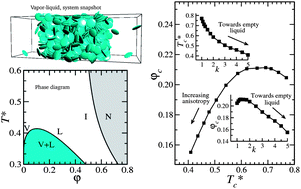Towards understanding the empty liquid of colloidal platelets: vapour–liquid phase coexistence of square-well oblate ellipsoids
Abstract
We study the phase behaviour of hard oblate ellipsoids with superimposed short-ranged oblate-shaped square-well attractions using the replica exchange Monte Carlo method and a simple van der Waals type perturbation theory. By fixing the square-well range (λ = 0.25σ‖), we examine the effect of varying the oblates aspect ratio, k = σ⊥/σ‖, on the density profiles, vapour–liquid and isotropic–nematic phase transitions. We observe that the formation of a liquid phase with vanishing density, an empty liquid, is possible with increasing aspect ratio. Surprisingly, the increasing shape anisotropy does not shift the stability region of the nematic phase to low densities, while the oblate-shaped square-well attraction favours disordered states. For k > 1.5, the critical temperature and packing fraction monotonically decrease with k, while the isotropic–nematic phase boundary moves towards higher packing fractions with decreasing temperature for all k. Simulations show that oblates preferably orientate their faces parallel to the vapour–liquid interface when located at the liquid side of the interface region and perpendicular when located at the vapour side.


 Please wait while we load your content...
Please wait while we load your content...